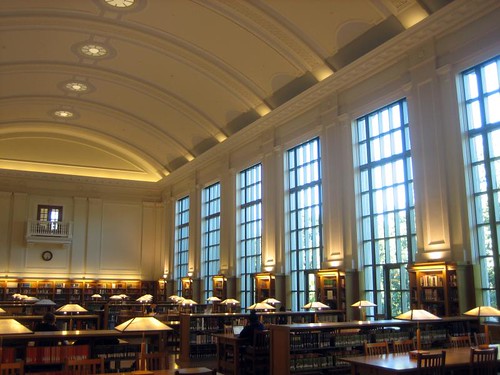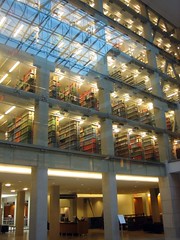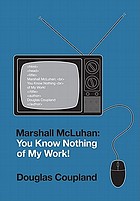Friday, December 16, 2011
New Eames Documentary
Video: EAMES: The Architect and The Painter - Trailer
Looks to be good. I've seen a few other docs that were OK-ish, but I like the editing in their trailer.
Airing on PBS' American Masters on Monday the 19th.
Labels:
Architecture,
artists
Friday, November 11, 2011
Shushing the Stereotypes
Video: Shushing the Stereotypes
Rebecca O'Neil (Westerville Public Library) and Rachel Rubin (Bexley Public Library) discuss 21st century librarians & libraries. The presentation was given on Nov. 10, 2011 at Pecha Kucha Columbus (OH).
Labels:
Library and Information Science
Thursday, October 13, 2011
Libraries: Virtual Models and Access
Here is an opinion article that focuses on moving towards digital and away from repository models. The libraries cited are academic and geared towards science, tech, med (STM). One wonders if the sections at the public library that handle these will transform just like audio/visual/media.
However, if we are moving more towards a digital access model in the academics, who owns the content and will access be granted after terminating a license to content not owned? Although STM materials date quickly, there are constituencies other than their primary audiences (e.g. humanities).
http://www.postbulletin.com/news/stories/display.php?id=1471618
The two libraries cited:
Missouri University of Science and Technology
The library is primarily virtual, in that it provides access to information that is not physically stored on the UMR campus.
Stanford University Engineering Library
Recently opened and the lion's share of their physical resources are stored off-site.
However, if we are moving more towards a digital access model in the academics, who owns the content and will access be granted after terminating a license to content not owned? Although STM materials date quickly, there are constituencies other than their primary audiences (e.g. humanities).
http://www.postbulletin.com/news/stories/display.php?id=1471618
The two libraries cited:
Missouri University of Science and Technology
The library is primarily virtual, in that it provides access to information that is not physically stored on the UMR campus.
Stanford University Engineering Library
Recently opened and the lion's share of their physical resources are stored off-site.
Labels:
Library and Information Science
Wednesday, October 12, 2011
Small Demons
Interesting concept where stories are deconstructed to provide more information about people, places, and things (e.g. music, food & beverages, etc.) mentioned in a story. Small Demons trademarked the term to describe this as the "storyverse."
If I were an advertiser, I'd be all over this. Which makes be wonder...how much product placement currently happens in novels?
Now in beta at https://www.smalldemons.com/
Labels:
Library and Information Science
Thursday, September 15, 2011
Johan Rijpma
Wachtmelodie from johan rijpma on Vimeo.
Johan's works have a great atmosphere. Their strangeness reminds me of Steven & Timothy Quay. While Guizmodo highlighted Johan's latest piece, I'd like to highlight Wachtmelodie, a stop-motion short that mixes photography, rubber bands, and video.
Labels:
artists
Wednesday, September 14, 2011
Barack Obama at Fort Hayes High School
Video: A montage of videos of Obama's visit to Fort Hayes H.S.
Yesterday I had the privilege to see & listen to President Barack Obama. He was promoting the American Jobs Act, and he showcased Fort Hayes Arts & Academic High School as an example of what the act could do for other schools across the nation. It was the first political event that I have witnessed, and I was surprised by my emotions which ran from excitement to concern. It seemed as if the whole thing was orchestrated--the crowd responding appropriately at each pregnant pause, at each call-to-action. Of course, this is exactly what good speech writing is intended to do. However, it made me question a crowd's ability for rational thought/discourse in the presence of a dynamic leader. Signs were not allowed within the assembly, but that didn't stop a man & women outside the gates from peacefully protesting for African American reparations [seen & heard playing trumpet at the end of the video].
Monday, September 12, 2011
Content, Kings, and Libraries
What happens when content is no longer king? What if we do move to a world where the medium is the message? How will this affect libraries?
I was reading the comment below that was posted on a review for Douglas Coupland's biography on Marshall McLuhan.
McLuhan is a central figure in speaking to what technology does to human beings, as was Jacques Ellul. Both these thinkers are extremely pessimistic so it's ironic that they're celebrated by technophiles. In this contradiction, I think, probably lies the heart of what digital technology is doing to content.
Content was king. Now content is giving way to that new 'something else' that can loosely be described as 'notion' - a creation of sound-bites, images, impressions, misquotes etc that attach to a singular emotion. McLuhan's content is terrifying; McLuhan's notion is however uplifting. We attach to his notion.
I really liked this review of the book.- J.S. Kitololo [Emphasis added]
If devices, such as mobile devices, change how we we think, how we organize, disseminate, and process information, what are the implications for the institutions we've created (i.e. libraries)? And if content truly is no longer king, do libraries need to place more resources into the medium?
Labels:
Library and Information Science
Sunday, August 28, 2011
Library of the Early Mind Update
Video: Library of the Early Mind Trailer:
Sad to have missed the screening of Library of the Early Mind: A grown-up look at children's literature when it came to The Ohio State University in May. According to their Facebook page, it will be available for digital download in autumn 2011 and dvd sometime thereafter.
Steven Withrow, the doc's co-producer, was kind enough to leave a comment on my original post in '09.
For more info, visit http://www.libraryoftheearlymind.com/
Labels:
Library and Information Science
Saturday, August 27, 2011
Obselidia
Video: Obselidia Movie Trailer:
Looks to be interesting.
"George (Michael Piccirilli) is a librarian assembling a collection of outdated ideas and inventions who believes that love is just one more obsolete concept, and Sophie (Gaynor Howe) is a projectionist who believes just the opposite." - Netflix
Labels:
Library and Information Science
Friday, August 26, 2011
Please Donate to Pelotonia 2011
Great video for a very worthy cause. Please donate here.
100% of every dollar raised by every rider and volunteer directly benefits cancer research at The Ohio State University Comprehensive Cancer Center - James Cancer Hospital and Solove Research Institute.
Labels:
pelotonia11
Foul Play
Video: Foul Play Original Trailer (1978):
Somehow this movie has not made all the top 10 lists. Note: Goldie Hawn's character is a librarian.
Labels:
Library and Information Science
Thursday, August 25, 2011
NYPL & The Real Winnie-the-Pooh

Image: NYPL's Winnie-the-Pooh Collection:
I recently learned that the New York Public Library owns the actual stuffed animals that Christopher Robin Milne played with. Time to plan another trip to NYC!
Labels:
Library and Information Science
Wednesday, August 24, 2011
Goodbye Columbus

Image: Goodbye Columbus Poster via IMDB:
Character Neil Klugman on working at the library.
Mrs. Ben Patimkin: "It must be very interesting...the library business."
Klugman: "I don't know. Yeah, I guess so."
Ouch.
http://www.youtube.com/watch?v=0M2xLSsy1XM#t=2m21s
Labels:
Library and Information Science
Monday, August 22, 2011
Pelotonia 2011 Please Join Me in Fighting Cancer
As you may or may not know, my grandmother, two grandfathers, and father had cancer. Their lives were cut short, and their void can not be filled. Each step closer we come to eradicating all forms of cancer means we are another step closer to stopping the pain and suffering caused by this disease.
The Event | On August 19th, Pelotonia11 launched a community of almost 5,000 riders and further engaged thousands of volunteers who continue to work tirelessly toward one goal - to find a cure for cancer. 100% of every dollar raised by every rider and volunteer directly benefits cancer research at The Ohio State University Comprehensive Cancer Center - James Cancer Hospital and Solove Research Institute.
The Success | Pelotonia09 netted $4.5M and Pelotonia10 netted $7.8M in proceeds for The James. Again, every dollar raised benefited cancer research! And, our Simply Community peloton raised approximately $40k in 2010 and we are enthusiastically pursuing far more this year!
The Ask | Respectfully, I ask for your support of our Simply Community peloton (if you have not already extended your generosity to others). Our “ask” is an eleven dollar ($11) donation in honor of Pelotonia11, the third anniversary of this amazing grassroots initiative.
To Pledge | Follow this link:
http://www.mypelotonia.org/riders_profile.jsp?MemberID=108050
It’s tough to acknowledge that cancer knows no strangers but it is absolutely true. Each of us is surrounded by too many family members and friends enduring a battle with this horrific disease. I believe the cure is inevitable but funding will support the speed by which it is discovered. Thank you.
Labels:
pelotonia11
Sunday, August 21, 2011
Black White + Gray
Video: Black White + Gray: A Portrait of Sam Wagstaff and Robert Mapplethorpe Trailer
An interesting documentary with, as you might have guessed, an emphasis on Wagstaff--a collector whose story I was not familiar with.
Labels:
artists
Saturday, August 20, 2011
Lynn Whipple

Image: Lynn Whipple's She Would Look Good in a Paper Bag
While in Orlando, FL, I came across Lynn Whipple's amazing mixed-media art. Her work was on display with other artists at the hotel that we were staying at which was near several arts institutions.
For more info, please visit http://lynnwhipple.com/
Labels:
artists
Friday, August 19, 2011
Thursday, August 18, 2011
Orlando Public Library

Image: Orlando Public Library
In June I had the good fortune to visit one of Urban Libraries Council's 2010 Top Innovators (PDF). Although the building exudes a certain sense of austerity, it was a pleasure to see the library bustling on a Sunday afternoon (although my pictures do not portray that...I usually shy away from taking pictures of people). When I entered the building, a lecture was just concluding, the children's area was hoping, and the entire library appeared to be well attended.
Flickr Slideshow: Orlando Public Library
Wednesday, August 17, 2011
Art of the Steal

Image: Art of the Steal Poster
Video: Art of the Steal Trailer
Recently, I watched Art of the Steal for the second time. Still upsetting.
Tuesday, August 16, 2011
Renovated OSU Thompson Library

Image: William Oxley Thompson Memorial Library Grand Reading Room
Last September, I had the opportunity to visit Ohio State University's newly renovated William Oxley Thompson Memorial Library as well as their renovated student center. Below are some pics from that trip.
One big takeaway is that the architects skillfully manipulated the stacks. Once seen as a dark, dingy, filthy, and, I guess to some, erotic [insert: ewww] place, the stacks have become a light-filled jewel within the library.

Thompson Library renovation architects: Acock Associates Architects/Gund Partnership
Flickr Slideshow: Ohio State University & the Thompson Library
Monday, August 15, 2011
Browsing, Libraries, & the Death of Serendipity

Image: Columbus Metropolitan Library Survey
I recently took an online survey for my library. The answers above struck me as I pondered how to answer. I realized that I no longer browsed shelves to find other like-kind titles. Instead, I am very mission driven when I enter the library. I have either placed a title on reserve, or I have ensured the title is available and have pulled the call number using the library's online catalog before I even set foot in the library. Even if the library were to institute a system within their online catalog to suggest additional titles (like Amazon), self-directed discovery has been lost.
I find this problematic for two reasons. First, I have found a number of interesting and though-provoking titles through serendipity--simply browsing the shelves and perusing titles at random. Second and more troubling, my library has become less about an experience and more about a transaction.
Labels:
Library and Information Science
Sunday, August 14, 2011
Renzo Piano and the Pierpont Morgan Library
Video: ARCHITECTURE - Renzo Piano - Morgan Library by fabriciopeixoto
Great light inside the library, but I wonder about the acoustics.
Saturday, August 13, 2011
Mount Angel Abbey Library
Design Excursion: Mount Angel Abbey Library Designed by Alvar Aalto from Matthew DiTullo on Vimeo.
Cool that Alvar Aalto and his wife also designed the library's furniture. Via Core77.
Thursday, August 11, 2011
SiteCake
Video: SiteCake Trailer
Super easy to create a website with maps, video, text, and other content. Users can drag, drop, and resize various components. Try a live demo at http://sitecake.com/
Super easy to create a website with maps, video, text, and other content. Users can drag, drop, and resize various components. Try a live demo at http://sitecake.com/
Labels:
Technology
Wednesday, August 10, 2011
Michael Porter and Library Renewal
I was quite impressed with Michael Porter's interview and call-to-action in the current issue of American Libraries. In the article "Libraries and the Future of Electronic Content Delivery," Porter clearly defines the threats and opportunities for libraries.
He then describes how Library Renewal, a "think and do tank," will focus on the follow three key areas: research, relationships, and outreach.
I certainly hope that Library Renewal focuses on more than just innovative ideas. The pragmatic implementation of solutions is absolutely critical for the future of libraries.
To learn more & get involved, visit libraryrenewal.org
Libraries either figure out new ways to be major players in a world where electronic content accounts for 85%–95% of content access (reading, research, music, and multimedia) or we become antiquated institutions that our local communities are less and less willing to support. - Michael Porter
He then describes how Library Renewal, a "think and do tank," will focus on the follow three key areas: research, relationships, and outreach.
I certainly hope that Library Renewal focuses on more than just innovative ideas. The pragmatic implementation of solutions is absolutely critical for the future of libraries.
To learn more & get involved, visit libraryrenewal.org
Labels:
Library and Information Science
Monday, August 08, 2011
Time to update for mobile (vid posted in ...
 | Time to update for mobile (vid posted in '09), but I still like the moxie.  youtube.com - I always feel like working at a library is just like the Matrix because everything we need to do our job is right here for us at our fingertips. Anything we want to learn from languages to marketing to... The Google+ project makes sharing on the web more like sharing in real-life. Join Google+ |
Sunday, August 07, 2011
Friday, August 05, 2011
Simplified Reality

Image: Simplified Reality slide from Engaging New Technologies: Productivity
Last March I had the pleasure of co-presenting with Meghan Musolff on current productivity technologies and possible future applications.
I thought about what the opposite of augmented reality would be. Due to the increasing levels of information complexity, simplicity has been a catchword for some time. Instead of increasing the layers of complexity with reality and the digital realm, what if we could eliminate some of the noise that Adbusters calls mental pollution?
Hence, a technology that simplifies our reality and allows us to focus on what is important to us during a particular time period. A simplified reality.
Well, when I read about the project between PublicAdCampaign, The Heavy Projects, and Junaio in the Fast Company article "Augmented Reality Kills The QR Code Star," I literally jumped from my chair. Currently in beta, the project removes advertising from billboards and subverts it. Of course, the app could be set to show a field of nothing but flowers, and it is the first step to a simplified reality.

Image: Junaio AR app created in conjunction with PublicAdCampaign and The Heavy Projects
Labels:
Library and Information Science
The Beautiful TU Delft Library

Image: Technical University Delft Library by Chris D.
Library Technical University Delft from ARCHITECTUUR.TV on Vimeo.
Labels:
Library and Information Science
Thursday, August 04, 2011
BIG - Bjarke Ingels Group Projects
BIG - Bjarke Ingels Group Projects 2001-2010 from beisistudio on Vimeo.
Nice way to sell a book.
Includes renderings from BIG's ambitious Astana National Library.
Labels:
Library and Information Science
Friday, May 20, 2011
Digital Books, Collection Development, & The Licensing Threat
Mike Matas of Push Pop Press demonstrates the potential of digital books. It is quite compelling. However, reading the comments, one realizes that control issues such a right of first sale are problematic. Libraries have had numerous issues with ownership in our digital world. Costs and user preference have driven libraries to collect digital-only journal subscriptions. Instead of purchasing a physical copy that a library can do with how it sees fit, a library purchases a license to access the issues. Without proper negotiation, the library can loose access to back issues if the library does not renew its contract. Thus, the entire collection may no longer be available to the library's patrons. I haven't really followed ebook licensing agreements, but now that tablets and ereaders have taken off and hit a certain saturation point, can we expect the same issues to affect libraries again?
[Side note: Also disconcerting is locking content into proprietary systems. Can we expect the content to perform across all ereaders/tablets? Will publishers form certain alliances with particular ereader/tablet/software manufacturers?]
Labels:
Library and Information Science
Saturday, February 26, 2011
Dylan Kehde

Image: Hanging Orb by Dylan Kehde
Dylan Kehde makes absolutely beautiful sculptures out of glass, light, & electricity. Don't call 'em light bulbs.
Labels:
artists
Tuesday, February 08, 2011
QR Codes in Libraries

QR code created using goQR.me
After reading about them for years, QR codes (i.e. quick response codes) have finally picked up traction here in the states. QR code's potential lies in automating information retrieval and bridging the physical world to online resources. By using the camera on one's smart device loaded with the appropriate software, users can take a picture of the code and automatically gather Web addresses, location and contact information, small amounts of text, and other important pieces of information.
Through QR codes, libraries are beginning to experiment with new ways to improve user experience and broaden users' information gathering capabilities. Examples includes linking to catalog records, reader advisory services, marketing/resource discovery through scavenger hunts, and other inventive uses. Contra Costa County Library's Snap & Go project has even partnered with the WestCAT busline to offer audio books via a download to the user's cell phone. From this perspective, the library is able to extend into non-traditional locations with minimal capital. The opportunities for libraries also include increased positive impressions and usage frequency. QR codes could be a powerful reinforcement of the library's commitment to the communities it serves.
With all the potential for QR codes, I can't help but ponder how their usage further increases a mobile divide. Librarians in the 90's rightly questioned how to provide services for those who do not own computers. The digital divide is still a concern, but less so now in the U.S. Libraries have, especially in urban settings, negated issues of the digital divide through computer acquisitions. However, mobile devices, in particular smart phones capable of reading & translating qr codes, can not be treated the same. The cost of acquiring smart devices just for additional resource discovery does not outweigh the benefit. Thus, the usage of QR codes is an added benefit for those who have the means to own the devices.
Libraries would also be diverting resources to a small, but admittedly growing, population. In 2010, CNN cited Forrester Research indicating smartphone ownership is only 17% of the 82% of Americans that actually have cell phones.
Personally, I would not let these issues deter me from incorporating QR codes within a library. The opportunity to increase information discovery, community touchpoints, and add greater value to users' experience outweigh the costs.
It will be interesting to see additional uses as well as how well QR codes are received and adopted--not only in our libraries but throughout our communities.
Further Reading
College & Research Libraries News: QR Codes and Academic Libraries
QR codes - Library Success: A Best Practices Wiki
Musings About Librarianship: QR Codes for Libraries - Some Thoughts
That's GREAT!: 101 Uses For Quick Response (QR) Codes: Creating Audience Engagement With The Next Killer US App
Mashable: HOW TO: Use QR codes for Small Business Marketing
Labels:
Library and Information Science
Saturday, February 05, 2011
Thursday, January 27, 2011
Duncan Fallowell's Library
"I'm a fish swimming in the aquarium of the intellect."
The Library from Sergey Stefanovich on Vimeo.
A journey through Duncan Fallowell's library which has spilled over into every available space and become an art installation in its own right. Duncan Fallowell talking.
Labels:
Library and Information Science
Subscribe to:
Posts (Atom)




